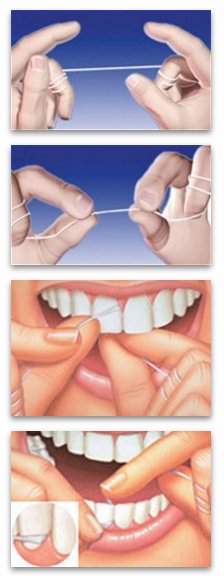
Dental Floss • Benefits of Flossing Teeth
The use of dental floss is essential in preventing dental diseases. Toothbrush can't reach difficult areas of the teeth as the interdental spaces. Using dental floss at least once a day provides effective removal of dental plaque and cleaning between the teeth. Regular dental flossing can benefit your dental health by reducing cavities, gum disease and bad breath.
Different types and History of Dental Floss
The history of dental floss seems to be relatively short, even though some researchers claim that they have found dental floss like thread between the teeth of ancient humans. The first dental floss -at the end of 19th century- was made by a thin thread of silk. Later silk was replaced by nylon thread that can be produced in greater lengths, consistent diameter and has better resistance to shredding during flossing.
Today there are commercially available many different types of dental floss :
- Waxed and Unwaxed dental floss
- Thread/String and Tape dental floss
- Flavored and Unflavored dental floss
- Teflon dental floss
Waxed versus unwaxed dental floss : normally an unwaxed, string dental floss should be chosen. If you have smaller spaces (interdental spaces) between teeth, classic floss could get stucked or shred. In these cases prefer waxed or/and teflon made dental flosses that slide more easily between the teeth. he best dental floss for you is the one you find easiest to use.
If you find it difficult to floss, you can use one of the flossing tools, such as a dental floss holder, flossing handle, or an electric or pre-threaded flosser. A dental floss threader can make it easier to floss when wearing fixed orthodontic braces, under bridges, implants and between connected crowns.
How to Floss Your Teeth - Dental Flossing technique
Most people floss only once a day, and many even less often. It is very important that you use the correct way to floss, in order to remove as much dental plaque as possible. The recommended flossing method is described here :
The correct way to floss

- Break off about 45-50 cm of floss and wind most of it (~30 cm) around one of your middle fingers. Wind the remaining floss around the same finger of the opposite hand. This finger will take up the floss as it becomes dirty.
- Hold the floss tightly between your thumbs and forefingers, leaving 3-5cm of floss between your hands.
- It doesn't matter from which tooth you start, as long as you keep the same order every date so that it gradually becomes a habit.
- Guide the dental floss to the space between your teeth using a gentle rubbing motion. Never snap the floss into the gums to avoid injuries.
- If the floss gets 'stuck' somewhere between teeth, use gentle back-and-forth motions to overcome the difficult point (this could be a sign of tooth decay in one of the teeth).
- When the floss reaches the gum line, curve it into a C shape against one tooth. Gently slide it under the gumline into the space between the gum and the tooth.
- Hold the floss tightly against the tooth. Gently rub the side of the tooth, moving the floss away from the gum with up and down motions. Repeat the motion 2-3 times for each of the 2 teeth on each side of the interdental space.
- Repeat this method on the rest of your teeth. Don't forget the back side of your back teeth.
- When the floss gets frayed or accumulates food residuals, unfold a new section of floss thread and wrap the used part on the other finger.
- It is important that you wash your mouth with water or mouthwash after flossing your teeth, so that the debris you have loosened up are rinsed out of your mouth.
Dental Flossing information and tips
- Why to floss? - The main benefit of flossing is the mechanical removal of food residuals and dental plaque bacteria from teeth and gums. Use of dental floss should be an indispensable part of your daily oral hygiene routine.
- When to floss? - Although it is suggested that we should floss after each meal, using dental floss even only once a day could be enough to keep you in good oral health, assuming of course that you do it thoroughly and effectively using proper flossing methods. If you use dental floss only once per day, prefer flossing teeth at night before you go to bed.
- How long to floss? - Regarding the duration of flossing, the answer is simple : 'as long it takes' (depending on your dexterity and expertise on how to use dental floss).
- What if my gums bleed? - It is normal to have some gum bleeding when flossing. Do not suspend flossing. On the contrary, gum bleeding is a sign that your oral hygiene is not perfect and you should be more persistent in brushing and flossing teeth.
- How to check if I floss properly? - After flossing use disclosing tablets to check if dental plaque has been removed.
Daily oral hygiene is essential for maintaining oral health. It should also be combined with proper healthy diet and regular dental visits.


